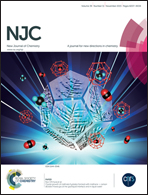Scratch-resistant sol–gel coatings on pristine polycarbonate†
Abstract
The deposition of protective transparent coatings on polycarbonate (PC) with higher scratch resistance than that of the polymeric substrate is performed using an original sol–gel system. Our strategy relies on the preparation of hybrid organic–inorganic (HOI) films using sol–gel based on 3-glycidoxypropyltrimethoxysilane (GPTMS), tetraethoxysilane (TEOS) and zirconium(IV) propoxide (ZTP). We demonstrate that despite a low coating-to-PC adhesion (<2 J m−2), it is possible to maintain the coating integrity under high applied scratch forces when the organic domains of the film are highly connected. In this case, the increase in organic network connectivity was achieved through the reaction of epoxide rings in the presence of ZTP, as evidenced by FTIR. The subsequent additional plasticity of the coating led to an increase in scratch-test delamination force by more than twofold: from 1.7 N for the hybrid film without ZTP to 3.8 N with the highest degree of ZTP content. In regard to the inorganic network, an increasing number of Si–O–Zr and Zr–O–Zr bonds with increasing ZTP content were evidenced by FTIR and 17O MAS NMR, allowing improved hydrolysis resistance, and therefore more durable coatings. Altogether, these results demonstrate the key role played by ZTP in tuning the mechanical properties and durability of HOI coating without requiring adhesion-promoting treatments.


 Please wait while we load your content...
Please wait while we load your content...